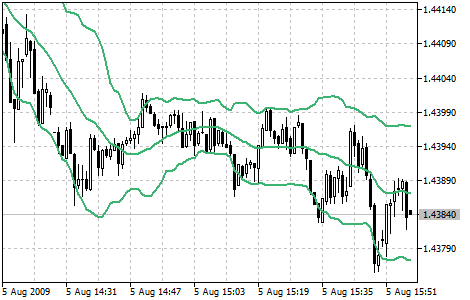Join our fan page
- Views:
- 38582
- Rating:
- Published:
- 2010.01.26 11:03
- Updated:
- 2016.11.22 07:32
-
Need a robot or indicator based on this code? Order it on Freelance Go to Freelance
Bollinger Bands ® technical indicator (BB) is similar to Envelopes. The only difference is that the bands of Envelopes are plotted a fixed distance (%) away from the moving average, while the Bollinger Bands are plotted a certain number of standard deviations away from it. Standard deviation is a measure of volatility, therefore Bollinger Bands adjust themselves to the market conditions. When the markets become more volatile, the bands widen and they contract during less volatile periods.
Bollinger Bands are usually plotted on the price chart, but they can be also added to the indicator chart. Just like in case of the Envelopes, the interpretation of the Bollinger Bands is based on the fact that the prices tend to remain in between the top and the bottom line of the bands. A distinctive feature of the Bollinger Band indicator is its variable width due to the volatility of prices. In periods of considerable price changes (i.e. of high volatility) the bands widen leaving a lot of room to the prices to move in. During standstill periods, or the periods of low volatility the band contracts keeping the prices within their limits.
The following traits are particular to the Bollinger Band:
- abrupt changes in prices tend to happen after the band has contracted due to decrease of volatility;
- if prices break through the upper band, a continuation of the current trend is to be expected;
- if the pikes and hollows outside the band are followed by pikes and hollows inside the band, a reverse of trend may occur;
- the price movement that has started from one of the band’s lines usually reaches the opposite one.
The last observation is useful for forecasting price guideposts.

Bollinger Band indicator
Calculation:
Bollinger bands are formed by three lines. The middle line (ML) is a usual Moving Average.
ML = SUM (CLOSE, N) / N = SMA (CLOSE, N)
The top line (TL) is the same as the middle line a certain number of standard deviations (D).
TL = ML + (D * StdDev)
The bottom line (BL) is the middle line shifted down by the same number of standard deviations.
BL = ML - (D * StdDev)
where:
- SUM (..., N) - sum over N periods;
- CLOSE - close price;
- N - number of periods used in calculation;
- SMA - Simple Moving Average;
- SQRT - square root;
- StdDev - standard deviation:
StdDev = SQRT (SUM ((CLOSE — SMA (CLOSE, N))^2, N)/N)
It is recommended to use 20-period Simple Moving Average as the middle line, and plot top and bottom lines two standard deviations away from it. Besides, moving averages of less than 10 periods are of little effect.
Translated from Russian by MetaQuotes Ltd.
Original code: https://www.mql5.com/ru/code/14
 Alligator
Alligator
The Alligator Indicator is a combination of Balance Lines (Moving Averages).
 Accumulation/Distribution
Accumulation/Distribution
The Accumulation/Distribution Indicator is determined by the changes in price and volume.
 Bears Power
Bears Power
The Bears Power Indicator measures the balance of the bears strength.
 BW-ZoneTrade
BW-ZoneTrade
The Indicator paints the bars according to the Trade Zones, as proposed by Bill Williams.